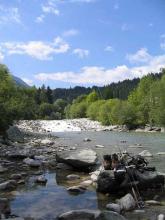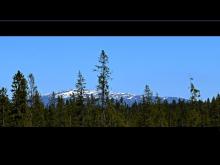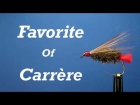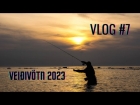Carinthian Gold
Does one of the best spots for fishing for graylings with a colour “like gold”, good water conditions most of the spring, summer and autumn, still undiscovered by cormorants and yet unknown to the cosmopolitan fly fishing scene sound interesting?
So where to go? You have certainly already heard about the famous German, Austrian or Swiss rivers and you certainly know about the beauty of the Slovenian waters.
So finally you get there and find the water clouded because of glacial water or a horde of cormorants has just “cleaned” the river right before your arrival… surely a nightmare to every fly-fisher!
The Gail
When discussing these unpleasant options with an experienced fly fishing friend, who has probably fished more waters from Iceland to New Zealand than one can imagine, he gave me a personal tip about the river Gail in southern Austria, right at the Italian border. Following his words one of the best spots for dry fishing on graylings with a colour “like gold”, good water conditions during most of the spring, summer and autumn season, still undiscovered by the cormorants and yet unknown to the cosmopolitan fly fishing scene.
Hotel Post
If you are checking for fly-fishing opportunities at the Carinthian Gail on the Internet you cannot avoid to find the homepage (www.flyfish.at) of Hotel Post in a village called Koetschach-Mauthen. The owners of the hotel, family Klauss-Lanzer, possess the fishing rights for the most interesting parts of the river Gail which are exclusively reserved for their hotel guests. In addition to that, hotel guests have fishing permission for three unique streams and for two lakes in the surrounding mountains of Koetschach-Mauthen-all in all they offer 33km of river banks for flyfishing. The family Klauss-Lanzer has decided to follow a strict fly-fish only philosophy in all their waters, which finally convinced me to book in for a week of fly fishing in Carinthia.
I was given a hearty welcome by Margit Klauss-Lanzer who is always at the reception desk and helps you with a first overview about the waters.
You get a detailed map with all fishable waters including parking areas and some catering options on the way. Most of the waters are divided into different sections and you will find helpful signs with these sector numbers on the riverbanks. Hotel Post also offers a small fly-fishing shop where you can buy some of the favourite Gail patterns and also offers beauty treatments for the ladies, yet I found a far better way to get rid of these worry lines during my stay… .
The Assnitz Stream
I started off by driving up in the mountains early to visit the “Assnitz” - a mountain stream that begins with a breathtaking waterfall and then descends into the valley where it flows into the Gail. On its way down, the water has formed big pools in which you can see mainly brown trouts, but also rainbow trouts, brook trouts and graylings standing in the crystal clear water behind big rocks. Some fish in these pools were constantly rising and impetuously taking offered BWO or Adams patterns, presented on a fluorocarbon leader. The more difficult part was to get into a position for a precise cast without being noticed by the very shy fish.
Half-lying-half-standing
This often meant creeping up behind the big rocks and performing a half-lying-half-standing cast. Although the clear water with most of the fish visible tempts to fish dry only, I would highly recommend to also concentrate on the big pools with a size 12-14 tungsten Hare's Ear or van Klinken's Leadhead nymph. To my own surprise a rainbow trout of a size I would have never expected in this water took my dark brown nymph pattern in one of those deep pools, making me stumble behind up hill and down dale by fighting its way through the next two following pools underneath without any chance of stopping with my 0.14mm leader. In the end, I lost that fish shortly before release, after I already got it in my hands-it was surely way over 50cm long. One can easily spend a whole day fishing the Assnitz. Another interesting spot especially during spring and autumn time seems to be the confluence of the Assnitz stream and the Gail. It was dry like always in summer during my stay but the streambed and stories from fly fishers who already have fished this part seemed promising.
The Gruensee Lake (Green Lake)
You have a passion for still water fly fishing? I sometimes have, so the next day I was up in the mountains to find the 31.000m2 large Gruensee lake (green lake) located in a breathtaking scenery.
Large lake trout (seeforelle), rainbow, brown and brook trout are patrolling along with big graylings in the clear water near the banks and on a calm summer morning you can see the fishes rising through a surface like glass. Luckily there is also a pontoon boat at free disposal which gives you a chance to fish the whole lake. Like in every clear stillwater of that kind, fish are very well educated, not easy to catch at all. Size 14 to 16 CDC dun patterns in grey colour brought me some nice brown and rainbow trouts from the bank in the morning. I may have caught more with a thinner tippet but after my experience at the Assnitz I decided not to use anything below a 0.14mm fluorocarbon diameter anymore.
Moutain stream
On the southern side of the lake, a small mountain stream flows into Gruensee lake. Just before entering the lake, the stream forms a sort of channel, which is one of the top spots for graylings in the lake. From a more elevated position on the side of this channel you have a perfect view down to the bottom of the water that is as clear as gin here. Several graylings were seemingly nymphing in the mid-water at that spot but I only caught some of the smaller graylings with a small goldhead nymph.
The bigger specimen constantly rejected everything out of my nymph fly box that had previously brought me good success. Occasionally one of the grayling group was rising with an impressive speed to the surface. I changed over to a dry presentation but likewise everything from Red Tag, Black Ant, palmered dry flies and CDC patterns in every size one could imagine was ignored. The breakthrough came with an emerger pattern, a small size 16 Klinkhammer with a grey Hare`s Ear body, which was taken by a 47cm grayling at once. One of the things you should not miss when you are visiting Gruensee lake is also to get on the pontoon boat and row to the dam wall at the northern end of the lake. Try to cast out some of your heavier goldhead nymphs, slowly stripping them back in. A couple of medium sized brook trouts fell in for that tactics although the number of fishes which would only run after the nymph without taking it was far bigger. Nymph tactics with a team of flies might seemingly have been even more successful, but fishing regulations do only allow one fly on the line.
The river Gail
Without any doubt-the river Gail is the main attraction of all the fishing waters in this area and especially the Gail section through the Lesachtal (Lesach valley) is a fascinating valley and still pretty wild. Locals also use to call this part of the Gail “little Canada” which seems comprehensible when you enter the Lesachtal for the first time. Away from civilization but still easy to access by car, the Gail offers a varied structure with deeper passages, narrow rocky parts, overhanging rocks, and barriers of logs suddenly barring the course of the swift-flowing waters of the river.
Brown trouts are not so frequent here but the population of rainbow trouts and graylings is very good. In white waters like these I prefer good visible, high floatant dry fly patterns with some white or yellow polypropylen fibres tied in which I feel helps me to control my drift more efficiently. The patters that I particularly like because of their excellent floating quality under such conditions are Buck Caddis with a slightly larger muddler style head or dry flies with a mixed body of short cut CDC feathers and deer/elk hair which were both responsible for a number of aggressively fighting rainbow trouts and some graylings in this section of the Gail. But beware-the Gail is for sure no “trophy water” with fish not smaller than 40cm and a guarantee for a trout 50+. You will also catch a fair number of smaller fish, all in good condition and an excellent base for keeping the Gail an interesting fly-fishing venue for the years ahead.
Placid and gentle
Flowing near to the village of Koetschach-Mauthen the Gail becomes more placid with gentle loops and gravel beaches with an easy access from all sides. The section underneath the weir of Koetschach-Mauthen is only a stone`s throw from the hotel away with the possibility for a quick visit after a long day of fishing on other waters. One of the best places for dry grayling fishing-though not the most beautiful compared to the beauty of the Lesachtal-is the lower Gail section close to the downstream end of the fishing district.
Even if you are not sure if the graylings are rising, give your size 14 to 16 dark dry fly patterns like Red Tag, Polywinged Midge, Bi-Visible, Griffith`s Gnat and especially CDC Dun patterns a chance! It is sometimes hard to actually see the graylings rising but they are there willing to take your fly and I met a couple of fly fishers who were reporting to fish only dry-fly for graylings throughout the year in the Gail. One thing I found extremely helpful when trying to find the best cast position when dry fishing for graylings was an opposite or even slightly upstream cast position. Graylings typically rise, track downstream and then take the fly still facing downstream before returning to its lie on the bottom. A downstream cast position therefore often virtually strikes the fly out of the grayling’s mouth before the fish has had time to take it properly.
Downstream and upstream
Fishing downstream brought the big rainbow trout, but fishing upstream gave me the best results for graylings although this meant laborious river wading where one could not cast from the bank-and yes, the fish colour is truly astonishing, nearly like gold in the last rays of a late summer evening, just as my friend had promised.
Short rain showers will cloud the Gail only short-term and still leaves a chance of nymph fishing. Heavy tungsten gold beads with a darker body and a little bit of sparkle are the key to success, likewise a variation with a copper head and a brown body proved to be successful for me as well.
Not in one day
You surely cannot fish all the Gail sections in one day. The hotel also offers guiding at a reasonable price (40€ for ½ day) which may save you some time but there are still so many different spots to fish that you should take not less than three days to get to know the various Gail sections. The selection of other waters offered and the length of the fishing district leaves fishing pressure on the Gail relatively low. Although there is still enough space for everyone and the Gail is still an insiders` tip, be prepared to meet some other fly fishers especially from Italy, Austria, France, Switzerland and Germany on this true European water.
The Valentin Gorge (Valentinklamm)
Although it seems hard to concentrate on anything else than the Gail, especially when visiting Carinthia only for a short trip, get yourself away from the river for a half-day and experience fishing in the Valentine gorge. Bad news first: You certainly won`t beat your personal trout record in that gorge. The relatively large brown trout population grows only to medium sizes in the cold waters of the gorge; occasionally you see rainbow and brook trouts. The water is as crystal-clear as the Assnitz and yet the fishing conditions are totally different. For the first 1.5km after entering the gorge, the Valentine steam is embedded within a slowly ascending rock face on both sides. Discovering interesting pools with fish in it was easy but catching some of these fish is a different story.
The gorge
My initial “conventional” tactic with getting as close to the pool as possible failed at once, most of the fish already escaping the pool just by lifting the rod tip. A different approach had to be chosen which meant casting from a longer distance without loosing control of the cast, which inevitably scares the trouts away. This more delicate presentation of a size 16 grey pheasant tail nymph finally brought some small to medium brown trouts.
Walking upstream, the gorge gets narrow, dark and the water gets wild. You begin to climb over rocks and through deep pools that the Valentine stream carved into the ground within thousand of years. That is the point where the trekking tourists, who also visit the gorge on sunny days, stop and from here you should put on a helmet that you can borrow at the hotel reception desk to protect you from the danger of little rockfalls. After passing the “gate of resurrection“-a big arch in the rock-a breathtaking scenery is waiting for you and you surely will forget about fishing at this stage.
More options
Hotel Post also offers different other fishing options. The Muehlbach, a small stream gently running through fields and meadows and the Valentine lake, which is like a smaller edition of the Gruensee lake. If you visit Koetschach-Mauthen then also do not forget to enjoy the Carinthian kitchen or just hop over to Italy for a quick culinary visit-the border is just 25 minutes by car away. Hotel Post has a nice continental breakfast buffet but no own restaurant. On your demand hotel staff will book a table in one of their partner restaurants where they serve you a special-price menue (about 14€ per person) for your evening meal. My personal recommendation is to visit Gasthaus Feistritzer-Huber in Mauthen. Although the ambience in the guest room is held simple, the food (and the beer!) is excellent-simply genuine, honest and fresh. A perfect end for a great day of fishing in the waters of the Carinthian gold.
Read more about why you should register.
More content from the front page
Since you got this far …
… I have a small favor to ask.
Long story short
Support the Global FlyFisher through several different channels, including PayPal.
Long story longer
The Global FlyFisher has been online since the mid-90's and has been free to access for everybody since day one – and will stay free for as long as I run it.
But that doesn't mean that it's free to run.
It costs money to drive a large site like this.
See more details about what you can do to help in this blog post.










































































Comments
This is a confusion
This is a confusion that is rather easy to understand... The german word "See" means lake and "Meer" is sea. So the "Seeforelle" should not be translated as sea trout, but as lake trout.
Recent update: Since
Recent update: Since April this year, Hotel Post and its fly fishing waters in Koetschach-Mauthen are leased by the Italian couple Deborah Vuan and Stefan Venchiarutti. Both have a background of working in the international top hotel business and Stefan is said to be a passionate fly fisher himself. I will keep you updated if the fly fishing options have changed after my next visit! Cheers, Tobias
Hello Martin, hello
Hello Martin, hello Ripley. Thanks for your comments. The question regarding "sea trouts" in Gruensee lake is a classical vocabulary mistake. Of course you find "lake trout" in Gruensee lake and no "sea trout". The German translation for "lake trout" is "Seeforelle" and so I just mixed things up. I apologize for this!
Yes, and fly fishing with a helmet is an interesting experience!
My special thanks goes out to Martin Joergensen who has made his article look great. Thanks again! Tobias
Very interesting art
Very interesting article. You mention sea trout in Gruensee, how come?
Great article Tobias
Great article Tobias.
One can only imagine the scenes in real life but your pictures speak a thousand words.
Have I ever done fly fishing in a helmet?
Actually - Yes! Once in Coeur d' Alene in Idaho back in 2002. Some of the streams are like the one in your picture "Valentin gorge". Fly fishing in a helmet is a strange sight but no one invites a rock in the head!
Another destination addition to the "to do" list.
Ripley